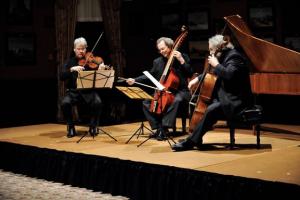- Home
- About
- About SCMS
- Directors
- Artists
- Vera Beths
- Steven Dann
- Marc Destrubé
- James Dunham
- Mark Fewer
- Eric Hoeprich
- Christopher Krueger
- Myron Lutzke
- Marilyn McDonald
- Douglas McNabney
- Mitzi Meyerson
- Pedja Muzijevic
- Anca Nicolau
- Jacques Ogg
- Loretta O'Sullivan
- Lambert Orkis
- Paolo Pandolfo
- William Purvis
- Marc Schachman
- Jaap Schröder
- Andrew Schwartz
- William Sharp
- Ian Swensen
- Lucy van Dael
- Ensembles
- Concerts
- The Collection
- Recordings
- Education
- Donate

The Esterházy Machine—Kenneth Slowik, baryton and fortepiano; Steven Dann, viola and violin; Myron Lutzke, violoncello—takes its name from a casual remark made by Dutch cellist Anner Bylsma, who referred to the baryton, favorite instrument of Joseph Haydn’s employer Prince Nikolaus Esterházy “the Magnificent,” as “that Esterházy machine.” With six bowed strings and nine sympathetic strings (which may also be plucked by the left thumb), the baryton is indeed an unwieldy-looking instrument that might have fallen into eternal oblivion at the end of the 1800s but for the fact that Haydn wrote nearly 200 pieces for it. In its baryton—viola—cello formation, the Esterházy Machine addresses this sonically unique repertoire, while its violin—cello—fortepiano configuration allows it to play the rich keyboard trio repertoire of Haydn, Mozart, and their contemporaries.


